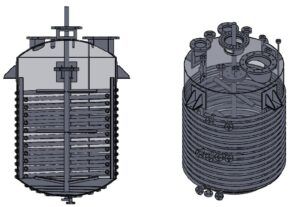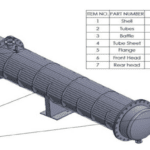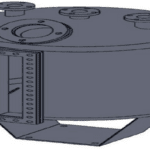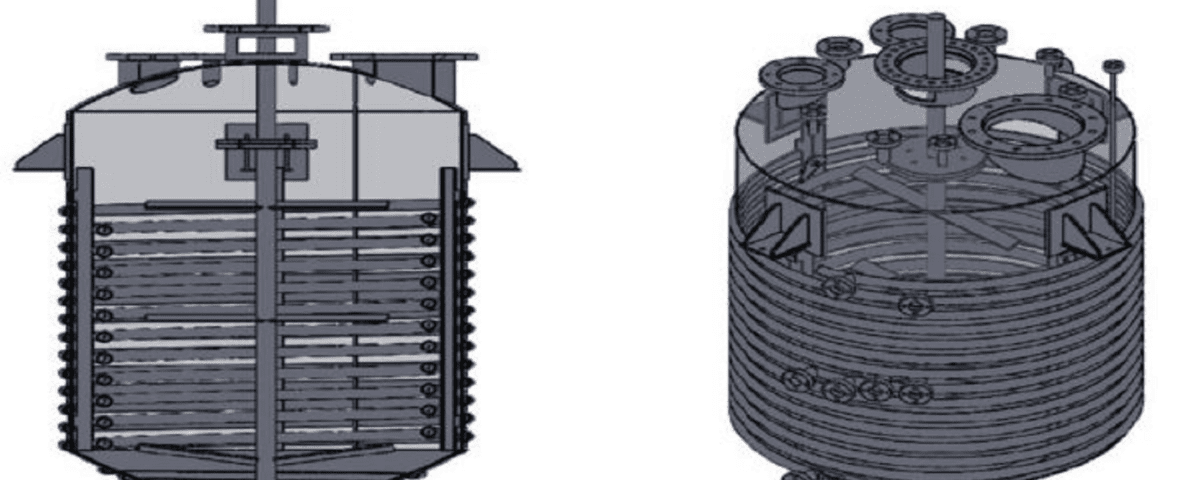Introduction
Shell-and-tube heat exchangers are among the most effective and widely used equipment in industrial processes for transferring heat between two fluids with different temperatures. Due to their simple structure, high efficiency, and reliability, these exchangers are used in various fields, including oil and gas, chemical, and power industries. Optimizing their design can greatly enhance energy efficiency, reduce costs, and improve system performance.
Project Overview
The primary objective of this project was to design a high-performance 10000-liter reactor with both external and internal coils and a vertical two-piece mixer. This reactor, constructed from S.S. 316L stainless steel, is suitable for a wide range of chemical reactions. Upon completion, this project provides you with four detailed construction drawings, including Body Drawing, 3D View, Mixer Drawing, and Nuzzles Orientation Layout. The drawings are available in AutoCAD, along with corresponding SolidWorks files. Notably, this reactor was manufactured in 2019 for a paint and resin unit in the Shiraz Industrial Town, where it is now operational.
Key Features of the Reactor Design
- Capacity and Material
This reactor has a capacity of 10000-liters and is made of S.S. 316L stainless steel, chosen for its high resistance to corrosion and chemical impact, making it ideal for industrial applications. - External and Internal Coils
A standout feature of this reactor is its dual-coil system, which effectively transfers heat to maintain precise temperature control. This is especially valuable in processes requiring temperature regulation. - Two-Piece Vertical Mixer
The vertical two-piece mixer is designed for uniform stirring and optimal agitation. It prevents sedimentation and improves reaction quality. - Versatile Reaction Capabilities
Engineered for diverse chemical reactions, this reactor can handle exothermic processes, acid or alkali reactions, and variable temperature and pressure conditions.
Design and Construction Process
Our engineering team utilized advanced tools such as SolidWorks for 3D design and AutoCAD for creating detailed construction drawings. The project output includes four essential sheets:

- Body Drawing: This sheet shows all the structural details, assisting manufacturers in adhering to precise specifications.
- 3D View: A comprehensive 3D view generated in SolidWorks enables engineering teams and stakeholders to visualize the final equipment, essential for simulating reactor performance.
- Mixer Drawing: Detailed specifications of the two-piece mixer, including blade dimensions and installation points, ensure efficient mixing.
- Nuzzles Orientation Layout: A layout specifying the positioning of fluid input and output nozzles, optimizing material flow and easing loading and unloading.
Material and Structure Significance in Reactor Performance
The use of S.S. 316L stainless steel, known for its anti-corrosive properties and durability, ensures suitability in chemical environments. This material’s resilience to acids and bases reduces deposits and corrosion, enabling continuous operation without frequent maintenance.
Applications and Benefits of the Reactor in Chemical Industries
Well-designed chemical reactors are vital for enhancing industrial processes, contributing to production efficiency, and maintaining product quality. The primary benefits include:
- Energy Efficiency: The heat transfer coils allow precise temperature control, improving energy efficiency and reducing operational costs.
- Reaction Time Reduction: With a powerful mixer and heat coils, this reactor shortens reaction times, boosting productivity.
- Cost Reduction: Precision engineering and the durable S.S. 316L material reduce maintenance needs and operating costs.
Provided Files and Drawings
Deliverables include:
- Construction Drawings: Body Drawing, Mixer Drawing, 3D View, and Nuzzles Orientation Layout.
- SolidWorks Files: These files facilitate 3D simulation and modeling.
- AutoCAD Files: Editable AutoCAD files of all drawings.
Conclusion
The 10000-liter reactor, designed and built by APIPCO, demonstrates significant progress in industrial equipment engineering and design. Its construction aligns with modern engineering standards, emphasizing efficiency and durability. The installation and successful operation of this reactor at a resin and paint unit in Shiraz validate its design’s effectiveness and APIPCO’s engineering capabilities.
This project exemplifies advanced 3D modeling, engineering design, and fabrication for high-performance chemical equipment, serving as a benchmark for similar applications in the industrial sector.


